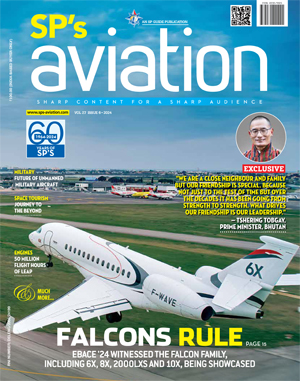INDIAN ARMED FORCES CHIEFS ON
OUR RELENTLESS AND FOCUSED PUBLISHING EFFORTS

SP Guide Publications puts forth a well compiled articulation of issues, pursuits and accomplishments of the Indian Army, over the years

I am confident that SP Guide Publications would continue to inform, inspire and influence.

My compliments to SP Guide Publications for informative and credible reportage on contemporary aerospace issues over the past six decades.
Expert Speak - Fractional Ownership is a Failed Model in India
CAPTAIN KARAN SINGH, President, Business Aviation Association for India, spoke to SP’s Chief Special Correspondent Sangeeta Saxena on the potentials and pitfalls in India’s business aviation environment
SP’s Aviation (SP’s): Describe the business aviation environment in India.
Captain Karan Singh (KS): There is a tremendous slowdown in the aviation sector currently, which follows the economic slowdown very closely. Orders are not getting fulfilled. But as an industry, we are bullish about general aviation. It will continue to grow.
SP’s: What are the debilitating issues?
KS: There are three major issues—infrastructure, manpower and regulations.
SP’s: What are the missing infrastructure requirements?
KS: Alternate airports in big cities are required. Hangars and parking have always been issues in business aviation. Smaller cities need airports, only then can business aviation penetrate all the markets in semi-urban areas. Heliports, which are very much the need of the industry, seem to be a remote possibility. Feasibility study of helicopter services in the National Capital Region has got shelved probably due to the existence of no flying zones. Mumbai has a fixed base operator, but it is under litigation; let’s hope it gets operational soon. We are woefully inadequate.
SP’s: Does India need an Act like the General Aviation Revitalisation Act 1994 of the US?
KS: Yes, we do. But it is still far fetched in India. Recognition to business aviation as an industry in itself is the priority.
SP’s: This year witnessed major layoffs in the aviation sector. Does it mean there is a surplus of manpower?
KS: No, there is a huge shortage of skilled manpower. We have a surplus of people who are not needed. They lack the required number of flying hours, have come with licences from foreign countries and do not fit the bill. Those who perfectly suit the requirement are very less and always in demand.
SP’s: What is the approach of the regulators towards the sector?
KS: It is a fragmented approach with too much of bureaucracy.
SP’s: In India, is fractional ownership synonymous with private ownership?
KS: No. It is a failed model in India. Even abroad it has not been very successful, whatever the pundits might say.
SP’s: What are the prospects for air charter companies in the prevailing environment of economic turmoil?
KS: Things are not as bad for the charter companies. But yes, it is a doubleedged sword.
SP’s: Given that private ownership is taxed heavily, which are the taxes you feel ought to be reconsidered by the government?
KS: Import duty on business aircraft is very short sighted. Service tax on charter services seems odd. Aviation turbine fuel excise duty also needs to be looked into.
SP’s: Compare India’s business aviation sector to its counterpart in the West.
KS: Business aviation in the West is an old concept. But in India, it’s still nascent.
SP’s: Enumerate some bureaucratic hurdles in India.
KS: First is the cumbersome process of acquiring an aircraft—it takes between three and nine months. Secondly, the RBI regulations to move money create a headache. Clearances for pilots pose the third biggest problem. Fourth is the import of the aircraft.
SP’s: Any shortcomings in the business aviation industry?
KS: Shortcomings yes, but not because of the industry. These are due to slow infrastructure growth and less expansion in the rural and semi-urban areas, which can give potential business.
SP’s: What is the role of BAAI in trying to improve the business aviation environment in India?
KS: We are not for complaints, we are for action. It is the only association recognised internationally. It looks into the problems of the sector and liaises with the government authorities. The Directorate General of Civil Aviation has welcomed the association and the Joint Secretary has been very appreciative of the fact that there is such a body. The aim of the association is to achieve efficiency and promote growth in the industry.
SP’s: How do you do that?
KS: We organise seminars and workshops to educate operators. We have made a data bank of each and every aircraft which comes into the country and follow its progress and action. We also request members of the association to give their professional inputs.





